feature
STEM Education Needs STEM Talk
Lessons learned from an after-school enrichment program with multilingual children
Science and Children—November/December 2021 (Volume 59, Issue 2)
By Frances Nebus Bose, Megan E. Lynch, and Carla Zembal-Saul
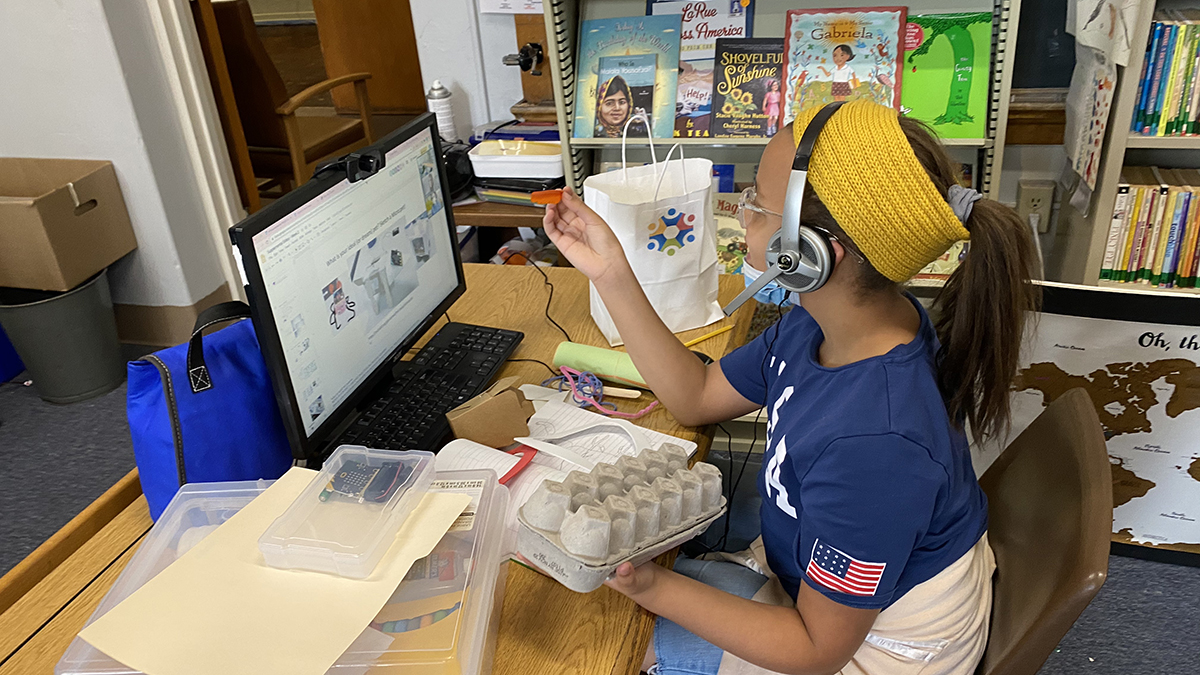
Multilingual children learning English often receive inequitable curriculum, instruction, and assessment opportunities in preK–5 schools where English is the dominant language of instruction (García and Kleifgen 2018). There is an even more prevalent gap when also considering access to high quality STEM learning opportunities (NASEM 2018). Why is STEM enrichment for multilingual children critical, even during a pandemic? STEM in early/elementary education can offer deep, productive content to engage all children and build on their lived experiences (Lee 2005). This is possible because it utilizes children’s innate curiosity about the world and fosters asking authentic questions about their community and local phenomena. When STEM teaching and curriculum is English-dominant without attention to the particular linguistic requirements expected, this opportunity presents a challenge for multilingual children, who may not know the content-specific academic language required (Lee, Quinn, and Valdés 2013). Through after-school enrichment where multilingual children can make their thinking visible by using multimodalities (e.g., gestures, visually sharing with detachable web camera) and with multilingual language scaffolding, more equitable STEM learning opportunities are possible. In this article, we share an example from a STEM investigation in an after-school program and provide recommendations for classrooms based on what we learned.
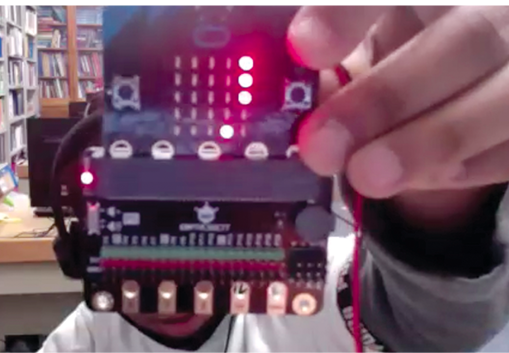
Project Overview
Over the last four years, we have provided STEM enrichment at a well-established community center in a new immigrant community, continuing a long-standing university-school-community partnership for the purpose of developing shared practices and resources for supporting language learning through Next Generation Science Standards (NGSS)–aligned science teaching and assessment. In spring 2020, the COVID-19 pandemic increased the urgency to meet the needs of children and families served by the center. With in-person programming suspended, we designed a virtual afterschool STEM enrichment opportunity for elementary school children for 10 weeks, one hour each week. Our project team brought on 14 preservice teachers (PSTs) to co-teach with five project instructors. We also partnered with a freelance engineer who designs and runs technology and coding programs for K–12 students to create STEM investigations with emphasis on engineering design.
Over the course of 10 sessions/10 weeks, children engaged in three investigations focused on engineering design with micro:bit devices. Micro:bits are exposed circuit boards that introduce block coding to beginners through the website https://microbit.org.
- Investigation 1 (sessions 2–4). We introduced the micro:bit and basic code blocks while engaging children in the engineering design process, resulting in incorporating a physical piece of hardware (micro:bit) into a tangible product (a “micro:pet”).
- Investigation 2 (sessions 5–7). Children learn to “write code” using basic code blocks to control two different output devices (the micro:bit LED matrix and speaker) based on two input devices (the accelerometer and pushbuttons), such that children design and create a stuffed animal/puppet and a piece of wearable tech (e.g., a watch, a name tag, necklace).
- Investigation 3 (sessions 8–10). Children continue learning about basic code blocks and input and output on the micro:bit and are introduced to circuits and conductors to collectively design an “orchestra” of interactive musical instruments made of unconventional materials.
Each virtual session began with children, PSTs, and project instructors meeting virtually in a central video-conferencing space. The majority of the sessions occurred in virtual breakout rooms where two PSTs led a pair of children through an investigation. Project instructors rotated between the breakout rooms to offer instructional support. In the final minutes of each session, everyone re-joined the central meeting room to share what they created.
The children were physically present at the community center and connected virtually to the PSTs and project instructors who were entirely remote. Because children were in-person at the community center, we followed COVID protocols, ensuring children maintained a distance of six feet and wore masks at all times. We created individualized kits with all of the needed materials (see Figure 1 for kits and associated costs) so that children did not have to share materials. In addition, in each room at the community center, the adult to child ratio was 1:5, with five or six adult volunteers.

STEM kits and associated costs.
Cost of materials per child:
BBC micro:bit $20
speaker $10
alligator clips $2
puppet supplies $9
miscellaneous arts and crafts supplies (purchased in bulk, repurposed) $5
Framework for Language Integration
Because many children taking part in the afterschool program were from families who immigrated from the Dominican Republic and whose home language was Spanish, our emphasis was on recognizing the multiple and creative ways children already made sense of engineering practices. We therefore considered language as constructing different combinations of multilingual STEM talk including home language varieties (including Spanish and English), gestures, and ways of working with materials (see Siry and Gorges 2020). To guide the PSTs, many of whom were English-dominant, we created scaffolds aligned to each engineering session embodying this multifaceted approach to recognizing and expanding language. These scaffolds attempted to aid PSTs in (1) recognizing the multiplicity of what language in science interactions can be, (2) cultivating this multiplicity by providing examples of how to integrate Spanish words, phrases, and morphemes into their teaching, and (3) expanding beyond the common practice of only directly translating materials. We do not expect PSTs to be proficient in the language of their students but that they consistently experiment with language to create a space for children’s full linguistic resources in STEM to be exercised and expanded. PSTs were adept at communicating with children by visually sharing materials and gesturing, yet more support was needed to integrate multilingual STEM talk. To illustrate this point, we share an interaction that exemplifies a common way engineering and constructing language coincided in the after-school program.
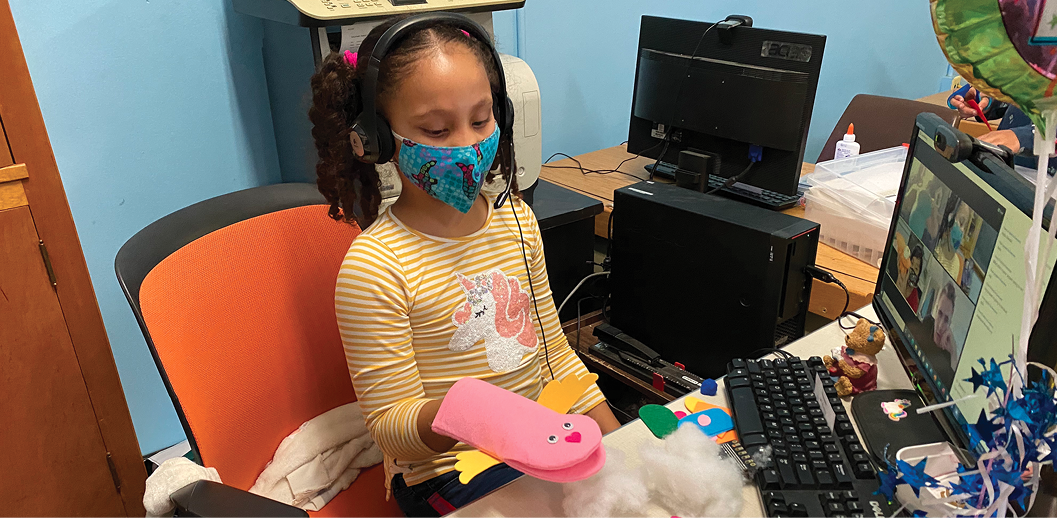
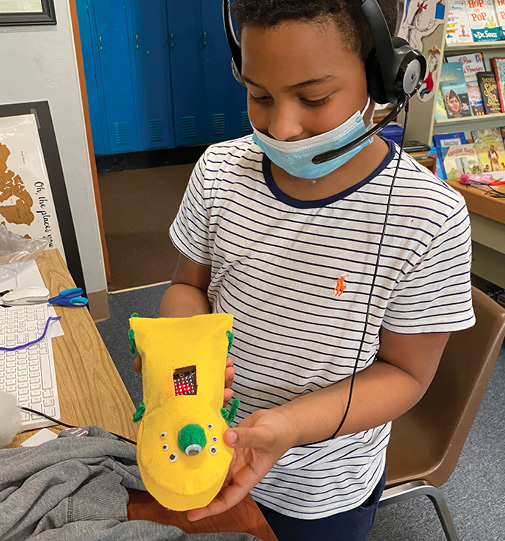
Example Case: Trouble-Shooting Code for Wearable Technology
In this example, we focus on the interaction between a multilingual child, Jason, and two PSTs in a breakout room session as Jason worked to code his micro:bit with lights and sound to incorporate in a piece of wearable technology. Although children’s home languages could be overheard at the community center between children and community educators, multilingual STEM-related talk between children and PSTs was absent in the virtual sessions. When the moment begins, Jason comments “nothing” is happening with his micro:bit. It is not working after he downloads his code. One PST responds by sharing her screen, saying, “compare my screen to yours....” Not having screen sharing capabilities, Jason creatively removes his detachable webcam and points it at his computer screen while saying, “everything.” He then explains that he does not know why he is having a problem. “I leave it like that,” Jason says, referring to his block code. Another PST then asks, “could you show us your code, Jason?” “My code. Yes,” Jason says. Jason nods his head in the affirmative, shows his screen with his webcam again, and says “everything.”
Over the next few minutes, the PSTs ask Jason questions to troubleshoot why his code is not working. One PST suggests the micro:bit was not plugged in, simultaneously making the gesture of two fists moving together. Jason then held up the cord to confirm it was plugged in. The PST then suggests the problem might be the speaker “The micro:bit?” Jason asks in response. “No, the accelerator,” one PST says, calling it by an incorrect term, as the other PST simultaneously holds the speaker close up to the video and points to a button that turns the speaker on and off. Jason goes back to working independently for several minutes and successfully changes his code so that his micro:bit lights up and makes sound. At the end of the session, the PSTs and children move from their breakout room to the central meeting room. Here Jason is silent, not sharing the process or content of his work.
What We Learned
Jason was able to successfully code his micro:bit. Jason’s ability to show materials and gestures resulted in needing to use very minimal STEM talk to complete the task. In fact, even when one PST used the term “accelerator” incorrectly, it did not seem to interfere with completing the task and is seemingly ignored and overridden by pointing and holding up the intended object, a speaker.
Yet was this an equitable learning opportunity for Jason? As Jason returns to the central meeting room he is seemingly at another disadvantage; sharing work with the whole group requires more specific language to contextualize the work for his peers and PSTs that had not been present during the process of construction. Little is known about what Jason understood of the task, what he could explain, connect to, and what language resources he could draw on in order to display what he knows about engineering content in expanded ways.
What else is needed to create an equitable STEM learning opportunity for Jason? Although the PSTs attempted to troubleshoot the problem with Jason by modeling specific terminology, asking to see Jason’s code, and holding up materials to the webcam, we believe the integration of more specific multilingual STEM talk is needed to make his thinking visible.
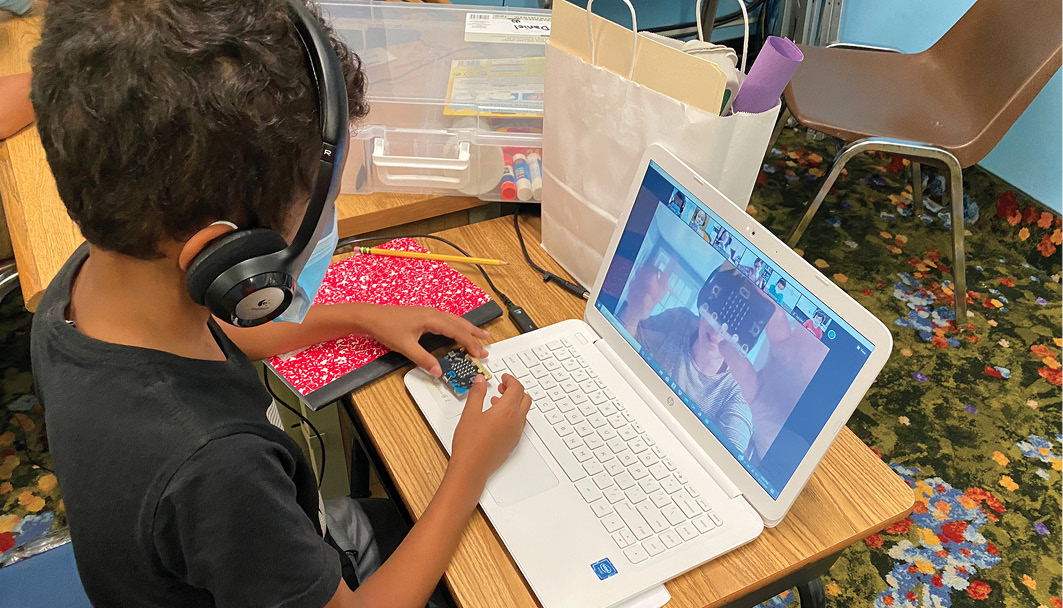
Helping Children See Themselves as Capable STEM Learners
It is imperative for multilingual children learning English that learning opportunities in STEM include more than the successful completion of a task. Multilingual children need the opportunity to make their thinking visible, which can be achieved through harnessing the synergistic power of STEM practices with multilingual and multimodal language practices. We offer three classroom recommendations to engage children in productive multilingual talk in STEM while continuing to build on and incorporate their creative and multimodal ways of communicating.
1. Synchronize Teacher and Children STEM Talk
a) Ask Questions as Children Work
By asking multilingual content-specific questions (e.g., “¿Cuéntame sobre el problema? How does your design work? When you remove the additional code block, que pasó?; What changes did you make to your design? ¿Porque?”) to children as they work, teachers create the opportunity for children to:
- articulate their noticings, learnings and process of design (Grapin et al. 2019; Board of Regents of the University of Wisconsin System 2017),
- try out and construct language to be performed at the end of the session, and
- model peer questioning for children to engage with one another.
How could this work for Jason as he troubleshoots his block code with PSTs? After his micro:bit successfully lights up and makes sound, we would ask him to talk and show what happened by asking questions like,“Cuéntanos sobre el problema. What steps did you take to solve it? ¿Como decidiste? Would you make the same choices again?” This would give Jason space to articulate his ideas while providing a content and linguistic model for his group members. In order to extend talk about the details of block coding, as Jason talks, we would hold up and turn the micro:bit and speaker, point to particular features of these materials and screen share block codes. By asking the questions with materials, gestures, and English-Spanish in combination, this would model for Jason that multiple forms are welcome and available to create his response. This can also provide an entry point for PSTs to find out more information about Jason’s linguistic resources to inform future instruction. Interspersing varieties of Spanish and English with multimodal ways of communicating further makes an explicit ideological stance: Spanish with visually sharing materials, images, gestures, and sounds are legitimate, academic, and welcome ways to share engineering knowledge.
b) Anticipate Potential Responses
Before asking these questions, anticipate what combinations of multilingual STEM talk at the morpheme, word, and sentence level might be needed to notice and respond to STEM ideas. Engaging with children in ways that expand language is difficult without determining ahead of time what language is required for the task. Figure 2 is a snapshot of supporting material shared with PSTs showing examples of differentiated language production (purple-complex; green-emergent) that may be needed to respond to the teacher’s question.

Connecting teacher questions to differentiated child language construction.
For Jason to answer teacher-initiated questions, we need to anticipate what STEM talk is required of Jason, so we can create scaffolds at the morpheme-, word-, and sentence-level to support, if needed.
For example, “Cuéntanos sobre el problema” may require ways of creating statements using several past tense structures, such as, “My micro:bit wouldn’t light up. One block code was giving the wrong information.” The question, “What steps did you take to solve it?” requires past tense verbs such as “designed, remembered, got, removed, coded” as well as ordinal language like “first, next, then, last”. “Would you make the same choices again?” requires more complex grammar to express conditionals such as “If I were to have this problem again, I could make sure I do not have two competing codes.” Children may also need to be explicitly taught word relationships such as between “competition, compete, competing, competed” and cognates “competición and competir” to extend linguistic understanding and ways of expressing.
It is our view that equitable STEM learning opportunities require teachers to not ask children questions without having thought through what is required of children to answer these questions and have resources available to support.
2. Record Videos for Sharing
To document children’s multiple ways of expressing their engagement in the engineering design process multimodally and multilingually, record one- to two-minute formative assessment videos at the end of each session. The content of the video can be particular to what each child did during the session and the particular language PSTs and children and language used. Video documentation includes the following benefits:
- a moment for children to reflect, bring together ideas, and articulate their understandings as they engage in investigations over time,
- a material and visual-based way of collectively constructing language in STEM,
- an opportunity to share recordings with families, thereby fostering deeper relationships, and
- a potentially less intimidating way of sharing information than in a whole group.
In the example with Jason, his answers to the PST’s questions can be captured on the video that is created in his small group. By responding to specific and scaffolded questions that he has been building toward answering throughout the session, and sharing for a smaller group of teachers and instructors that have seen his work over time, his ideas have the possibility of becoming more visible and heard.
Conclusion
We shared our experiences designing, teaching, and learning from a virtual STEM after-school enrichment program for young multilingual children in a new immigrant community during the COVID-19 pandemic. Responding to a larger pattern observed as children and PSTs completed design tasks in a virtual setting, we showed an example case of highly visual and material-rich ways of successfully engaging in block coding to design wearable technology. We also recognized how the integration of more specific multilingual STEM talk was needed for Jason to make his learning visible. Focusing on helping children see themselves as capable STEM learners, we presented three classroom recommendations that provide continued ways to recognize and cultivate the multiple and creative ways children already make sense of the designed world while also supporting children in expanding ways of making these ideas known. Our aim is that through intentionally linking teacher and child language in multilingual and multimodal STEM interactions, we create multiple pathways for children’s ideas about STEM to matter and be recognized by their peers, teachers, and families. ●
Acknowledgment
Research discussed in this paper was supported by a National Professional Development Grant (T365Z160311) from the US Department of Education’s Office of English Language Acquisition. This work would not be possible without the additional support of the Hazleton Integration Project (https://hip1.org); the Science 20/20 team (https://www.science2020k-5.com); and Cheryl Monroe, freelance engineer and community educator (GadgetGirls@outlook.com)
Frances Nebus Bose (fnb105@psu.edu) is a postdoctoral research associate, and Carla Zembal-Saul is a professor of education in science education and holds the Kahn endowed professorship in STEM education, both at Pennsylvania State University in University Park, Pennsylvania. Megan E. Lynch is a postdoctoral fellow at the University of North Florida in Jacksonville. All are part of the project Science 20/20: Bringing Language Learners into Focus through Community, School, and University Partnership.
Inclusion Literacy STEM Technology Elementary


